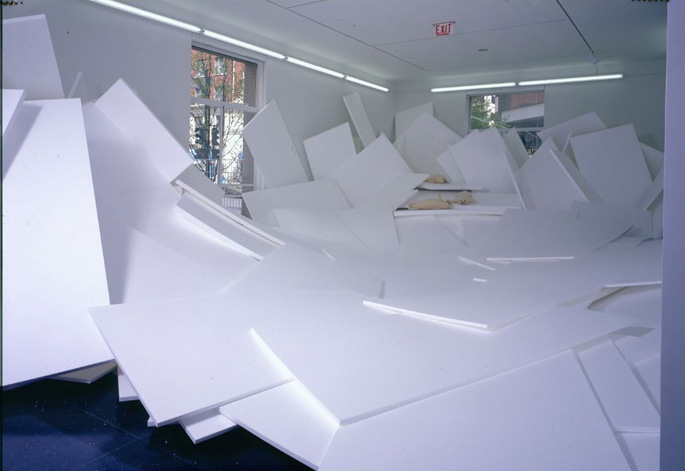General Idea


Past exhibition
General Idea
About the Exhibition
The Arts Club of Chicago will inaugurate its new headquarters at 201 East Ontario Street with the opening of the first Chicago exhibition of the Canadian artists’ collaborative General Idea. Club members and the public are welcome to a reception at which AA Bronson, one of the artists, will be present from 2 to 4 p.m. The exhibition will continue through May 21.
A catalogue, with an essay by critic Joshua Decter, the original maquette provided by Bronson, accompanies the exhibition. In that essay Decter says:
“Since General Idea’s exceptionally unique collaborations began in the late 1960s, their work invariably has sought to articulate a symbolic place between the artistic vanguard (i.e., subculture) on the one hand, and the glamorous, image-based milieu of popular culture on the other. Inhabiting the role of artists like a troupe of performers involved in a grandly ironic masquerade that has its conceptual roots in Dada, Fluxus, performance art, and Pop among other historical models, Partz, Zontal, and AA Bronson invented new formal strategies to amplify the theatricality of artmaking. The chameleonlike (self)transformations of General Idea over the past three decades have been remarkable, as they took the pulse of each era and then responded: from the 1970s FILE Megazine (the anti-Life magazine through which General Idea investigated the semiotics of popular culture) to the 1984 Miss General Idea Pageant and Miss General Idea Pavillion (two long-term conceptual framing devices that provided structural coherence for a range of performances, events, and installations), to the wonderfully naughty and daring poodle paintings of the 1980s that took on the ubiquitous neo-geo style but were also elegantly vibrant emblems of a gay Kama Sutra.”
After 1987, General Idea focused on projects dealing with AIDS and its implications. In response to a New York AMFAR benefit that year, the group resuscitated Robert Indiana’s LOVE painting of 1967, substituting the words AIDS and imbuing the familiar icon with a more alarming content. “We want to make the word AIDS normal,” they stated. “Keeping the word visible… will hopefully play a part in normalizing people’s relationship to the disease [and] make it something that can be dealt with as a disease rather than a set of moral or ethical issues.” Over the next seven years, General Idea carried out over fifty projects using the AIDS logo.
The Arts Club of Chicago will present General Ideas white-on-white AIDS wallpaper and paintings, as well as the major installation, Fin de Siècle (1990). In Fin de Siècle , three life-size synthetic harp seal pups are adrift on an ice floe made of hundreds of sheets of polystyrene. Reminiscent of Caspar David Friedrich’s famous romantic painting The Wreck of the Hope (1824), the installation is a self-portrait in the age of AIDS, in which the artists become the endangered species.
Also on view will be a new sculptural piece, Untitled (1997), by California artist Jim Isermann, inaugurating The Arts Club’s Project Space currently located at the top of the Mies van der Rohe stair. The Project Space will allow the Club to show single pieces, small exhibitions, and site-specific installation on an informal basis.
About the Artists
AA Bronson, born Michael Tims in Vancouver in 1946, studied at the School of Architecture, University of Manitoba, Winnipeg, and lives and works in Toronto. Felix Partz, born Ron Gabe in Winnipeg in 1945, studied at the School of Fine Arts, University of Manitoba; and Jorge Zontal, born Slobodan Saia-Levi in Parma, Italy, in 1949, grew up in Caracas as Jorge Saia, and received a B.A. in architecture from Dalhousie University, Halifax. Both Partz and Zontal died in Toronto in 1994. Their quarter-century artistic collaboration is unique in art history.
Often referencing high-art styles of the recent past (such as Op, Pop, and Patter and Decoration), Jim Isermann is interested in handmade work and in the activity of producing it. His earlier works include latch-hook rugs paired with oil paintings, fabric wall hangings, and patchwork quilts. The 52-inch “minimalist” cube at The Arts Club, his largest work to date, incorporates ten yards of bright cotton hand-woven by the artist. And eye-dazzling plaid of saturated colors—red, blue, yellow, orange, and green—is repeated entirely on each side of the piece and derives from Isermann’s study of the color theory of designer Verner Panton. Modernism, furniture design, and functionalism are among the artist’s concerns; the self-conscious combination of austere form with skilled handicraft and optical vitality seen in the woven cube led critic Michael Ducan to characterize Isermann’s objects as “intellectual works on can cuddle up to.” The sculpture will be on view through May 30.